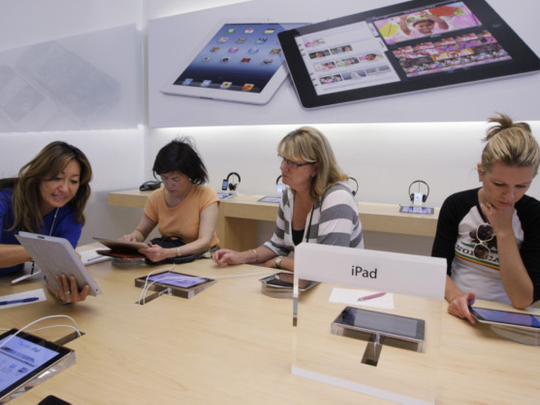
San Jose: A paid Apple Inc witness testified in the company’s patent case against Samsung Electronics Co. that he studied a report finding that Best Buy Co. customers mistakenly bought Samsung products thinking they were Apple’s.
Peter Bressler, an industrial designer who said Apple has paid him a total of $75,000 so far in the trial, yesterday told jurors in federal court in San Jose, California, about data in a report showing that the most common reason Best Buy customers return Samsung’s Galaxy Tab 10.1 tablet computer is because they thought they had bought the iPad 2.
During cross-examination, Samsung’s attorney, Charles K. Verhoeven, confronted Bressler with video-taped deposition testimony from April 2012, in which the designer was asked if he believed that consumers purchasing products get confused between Apple and Samsung products.
“I do not know if they get confused,” Bressler said, testifying as an expert witness in the second week of the trial.
Apple and Samsung are the world’s largest makers of the high-end handheld devices that blend the functionality of a phone and a computer. The trial is the first before a US jury in a battle being waged on four continents for dominance in a smartphone market valued at $219.1 billion. Each company is trying to convince jurors at the trial that its rival infringed patents covering designs and technology.
‘User Research’
Bressler is an expert in “user research, human factors application, manufacturing processes and innovative criteria conflict resolution,” according to the website for his company, Philadelphia-based BresslerGroup. His testimony may continue to lay the groundwork for Apple’s infringement claims, which Apple started last week with Scott Forstall, the company’s senior vice president in charge of iPhone and iPad software. He gave jurors the first detailed testimony about one of the patents at issue.
Apple seeks $2.5 billion for its claims that Samsung infringed patents. Samsung, based in Suwon, South Korea, countersued and will present claims that Apple is infringing two patents covering mobile-technology standards and three utility patents. Apple, based in Cupertino, California, also wants to make permanent a preliminary ban it won on US sales of a Samsung tablet, and extend the ban to Samsung smartphones.
70 Patents
Bressler, who is an inventor on 70 design and utility patents and teaches product design at the University of Pennsylvania, said he had studied different versions of the iPhone in preparation for his testimony. Shown diagrams from Apple’s patents and actual phones based on them, he described the “rectangular proportion” of the diagrams as providing “a specific impression or design.”
The phones “embody the design of the patent,” he said in response to questions from Apple’s lawyer, Rachel Krevans.
Bressler said he performed an infringement analysis of the Galaxy S 4G phone and found that its “flat, uninterrupted surface” and “rectangular proportions” infringe Apple’s patents. He said he arrived at the same conclusion after doing a similar analysis for more than 10 other Samsung phones and a Samsung tablet.
Court Order
Before trial, Apple won a court order from US District Judge Lucy Koh temporarily blocking US sales of Samsung’s Galaxy Tab 10.1 tablet, a ruling that was upheld by the US Court of Appeals for the Federal Circuit in Washington.
Bressler said the “prior art,” or earlier inventions, that Samsung argues are in patents preceding Apple’s describe a different product. Those patents Samsung is relying on to defend against the infringement claims describe front screens that are convex, not flat, he said.
During cross-examination, Samsung’s attorney showed Bressler images of smartphones, including LG Electronics Inc’s Prada, comparing the images to an image from the patent Apple accuses Samsung of infringing.
“Each of the images we’ve looked at are rectangular in shape with rounded corners,” Verhoeven said.
Verhoeven asked Bressler if all the images have a large, centred screen, narrower lateral borders and larger borders above and below the screen, and a lozenge-shaped slot for the speaker.
Bressler acknowledged the similarities, while noting that not all the images depict a bezel, a band of metal wrapping around the phones.
‘That’s Important’
“The absence of a bezel, that’s important, right?” Verhoeven asked. “It takes you out of ‘substantial similarity,’” Verhoeven asked. He asked whether an “ordinary observer” evaluating patents is supposed to take into account prior inventions and “focus on differences, right.”
Such an analysis requires one to look at “all views of the patent,” Bressler said. “You can’t get that understanding from a single view,” he said.
Susan Busch, a Best Buy spokeswoman, didn’t immediately return phone and e-mail messages after regular business hours seeking comment on the trial testimony.
Earlier yesterday the jury heard from Samsung Vice President Justin Denison, the company’s chief strategy officer for Samsung Telecommunications America, who said he finds “offensive” claims his company is copying Apple.
Samsung is proud of the “products it produces, and all the hard work that goes into bringing those products to market,” Denison said. Samsung “does an excellent job of remaining very humble,” with its employees possessing a “self-critical” attitude that drives “change, innovation,” Denison said, responding to questions from Samsung’s lawyer, John Quinn.
Today’s Witness
Today, Apple is scheduled to call as a witness a former graphics and digital font designer for the company, Susan Kare.
Kare began her career at Apple as the screen graphics and digital font designer for the original Macintosh computer, according to her website. Now at Susan Kare User Interface Graphics in San Francisco, she has done iPhone application graphics, as well as images for Facebook Inc and Microsoft Corp, according to the site.
“Good icons should be more like road signs than illustrations, easily comprehensible, and not cluttered with extraneous detail,” according to her website. “Just because millions of colours are available, every one need not be used in every icon.”










